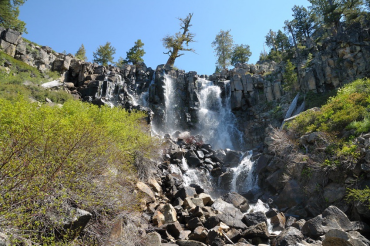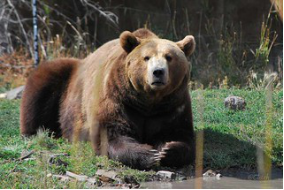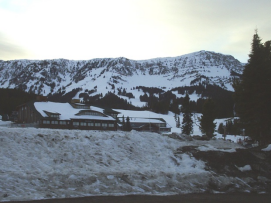Bozeman, Montana, USA 作者: 来源: 发布时间:2021-01-27
I. Population and Area
₋ Area
Land: 49.52 km2 (19.12 sq mi)
₋ Population (2019)
Total: 49,831
Density: 1,900/sq mi (750/km2)
II. Natural Geography
Bozeman Pass

₋ Bozeman is located in the southwestern part of Montana and is a great place for those seeking clean, fresh air and a relaxing environment. While Bozeman may be one of the larger towns in Montana, it retains a small town feel.
₋ National forests and trails are easily accessible, making it a great place for outdoor recreation. There are also many shops, parks, arts opportunities and museums within Bozeman, and this college town is always buzzing with activity.
₋ Nestled in a valley and surrounded by mountains, Bozeman is the urban base for adventure that is associated with the American Northwest. Hiking, biking, climbing, rafting, skiing, fishing—just about anything one can think of to do outside, Bozeman has it. Within the city there are a variety of restaurants, lots of craft beer breweries, and a few distilleries. —Rishad Mehta
III. Economy
₋ The average income of a Bozeman resident is $26,350 a year. The US average is $28,555 a year.
IV. Industrial Characteristics
- Technology industries, such as bio-science and photonics, are growing in number. People move here for the lifestyle, but with a range of large companies such as Oracle, to smaller yet competitive firms like Elixiter, people in Bozeman have great employment options. Montana State University turns out exemplary candidates, giving companies another great reason to locate here. Outdoor manufacturing brands like Simms and Mystery Ranch are right at home in this outdoor mecca and employees are expected to spend time outdoors using the products they are producing.
V. Attractions
1. Museum of the Rockies (MOR)

₋ Museum of the Rockies (MOR) is an independent 501(c)(3) non-profit institution, a college-level division of Montana State University, a Smithsonian Affiliate, and a repository for state and federal fossils. MOR is recognized as one of the world's finest research and history museums. It is renowned for displaying an extensive collection of dinosaur fossils, including the mounted Montana's T. rex skeleton!
₋ MOR delights members and visitors with changing exhibits from around the world, regional and natural history exhibits, planetarium shows, educational programs & camps, insightful lectures, benefit events, and a museum store.
₋ Accredited by the American Alliance of Museums, MOR is one of 1,083 museums to hold this distinction from the more than 35,000 museums nationwide. The museum is also a member of The Association of Science-Technology Centers (ASTC) Travel Passport Program and the Montana Dinosaur Trail.
₋ The museum is proud to have sister-museum relationships with the Carter County Museum, Mifune Dinosaur Museum, Aso Volcano Museum, and the Fukui Prefectural Dinosaur Museum.
₋ The museum's collections focus on the physical and cultural history of the Rocky Mountains and the people and animals who have lived there, and date back more than 500 million years. Permanent exhibits include: "Enduring Peoples", which chronicles the life of Native Americans on the Northern Plains and near the Rocky Mountains; "History of the Northern Rocky Mountain Region", whose inhabitants included Native Americans, fur traders, gold seekers, and white settlers from frontier days through World War II; the Living History Farm, which includes the Tinsley House, where costumed interpreters demonstrate life in a turn-of-the-century home; and the Taylor Planetarium, a 40 ft (12 m), 104-seat domed theater.
2. Palisade Falls

₋ Palisade Falls is located south of Bozeman in the Hyalite Recreation Area, just beyond the reservoir. The trail begins at the East Fork of Hyalite Creek, then follows a tributary for approximately half a mile to a bridge fronting the falls. Palisade Falls is a towering cataract dropping more than 80 feet off a vertical rock wall at the southern base of Palisade Mountain. The trail is wheelchair- and stroller-accessible, mostly paved, and features picnic tables at the trailhead.
₋ Seasonal Conditions
This is a great, easy trail during the heat of summer, when the falls and dense forest keep hikers, bikers, and runners cool. The trail can get slick during winter, but good traction or a pair of cross-country skis make for an easy winter outing.
₋ Address: Bozeman, MT 59718, United States
3. Montana Grizzly Encounter

₋ Welcome to Montana Grizzly Encounter; a Grizzly Bear Rescue & Education Sanctuary in Bozeman, Montana. Founded in 2004, MGE provides a spacious and natural home for rescued grizzlies. At the same time it offers the public a place to come and learn about grizzly bears as they watch the majestic animals “up close” in a beautiful mountain setting. Three of our five bears were born in unfortunate captive situations and could NEVER be released into the wild. The bears have been rescued from often inhumane captive situations all over the U.S. Bella and Max are our only wild born rescues, both had been orphaned at a young age in different parts of Alaska.
₋ We provide the bears with the best possible life here at the sanctuary. At the same time we give people an opportunity to see and understand this awesome creature safely, up close, with no bars or cages to obstruct the view. The Grizzly Encounter is open to school groups free of charge, and each year thousands of children learn about grizzly bear safety and conservation. In this way, Brutus, Bella, Sheena, Maggi, Max, and Montana Grizzly Encounter are doing their best to help insure that there will be wild bears in our forests for generations to come.
₋ Montana Grizzly Encounter receives no government funding. Without YOUR support, Montana Grizzly Encounter could not survive and grow. We need your help to continue to provide a great home for rescued grizzly bears and to work to insure that grizzly bears continue to live in the wild. Donations to Montana Grizzly Encounter are not tax-deductible.
4. Bridger Bowl

₋ Bridger Bowl
The ski area is located on the east slope of the Bridger Mountain Range. With four large bowls within the boundaries, the ski area offers wide-open terrain with a variety of landscapes including long, wide-open slopes, glades, chutes and gullies.
The mountain lays out in a large funnel or "V" shape expanding from about 200 yards in width across the base area up to approximately 2 miles wide across the ridge top.
Family and friends of varying skill levels can ride several of our chair lifts together while still enjoying varying terrain best matching their individually ability.
Bridger Bowl's terrain difficulty rating (beginner to expert) is fairly easy to determine based on elevation.
Generally speaking, the ski area offers first-time beginner slopes in the base area, novice terrain across the lower middle, wide-open intermediate runs in the center, advanced open bowl terrain in the upper third and, finally, expert terrain coming off the ridge top.
₋ Ridge Terrain
Bridger Bowl’s Ridge Terrain presents some of the most challenging skiing and riding within any ski area boundary. Numerous steep chutes, rock cliffs, and snow fields which may end in cliffs with no hazard markings, no grooming and no marked trails.
An avalanche transceiver (457 khz) is required for all skiers and snowboarders to access Bridger’s Ridge Terrain including riding Schlasman’s Lift.
It is strongly recommended to have a partner, a shovel and expert skiing or snowboarding abilities in addition to knowledge of the terrain before venturing into any of Bridger's designated lift or hike-accessed ridge terrain (View Ridge Guide).
₋ Terrain Park
Bridger Bowl has two terrain parks accessed from the Sunny side Lift. Bridger promotes SMART safety to keep our terrain parks a fun and safe palce for everyone!
An advanced park on upper Sunny side run with more challenging features and larger jumps. Features change with conditions. A small park with a series of rails, boxes and jumps on the lower part of Sunnyside run.
₋ Tel: +1 406-587-2111 / +1 800-223-9609
₋ Email: admin@bridgerbowl.com
₋ Address: 15795 Bridger Canyon Road, Bozeman, Montana 59715
VI. History
₋ Early history
For thousands of years indigenous people of the United States, including Shoshone, Nez perce, Blackfeet, Flathead, Crow Nation and Sioux traveled through the area, called the “Valley of the Flowers”, although the Gallatin Valley, in which Bozeman is located, was primarily within the territory of the Crow people.
₋ Nineteenth Century
William Clark visited the area in July 1806 as he traveled east from Three Forks along the Gallatin River. The party camped 3 miles (4.8 km) east of what is now Bozeman, at the mouth of Kelly Canyon. The journal entries from Clark's party briefly describe the future city's location.
John Bozeman
▫ In 1863, along with a partner named John Jacobs, opened the Bozeman Trail, a new northern trail off the Oregon Trail leading to the mining town of Virginia City through the Gallatin Valley and the future location of the city of Bozeman.
▫ John Bozeman, with Daniel Rouse and William Beall, platted the town in August 1864, stating "standing right in the gate of the mountains ready to swallow up all tenderfeet that would reach the territory from the east, with their golden fleeces to be taken care of”. Red Cloud's War closed the Bozeman Trail in 1868, but the town's fertile land still attracted permanent settlers.
Nelson
▫ In 1866, Nelson Story, a successful Virginia City, Montana, gold miner originally from Ohio, entered the cattle business. Story braved the hostile Bozeman Trail to successfully drive some 1,000 head of longhorn cattle into Paradise Valley just east of Bozeman. Eluding the U.S. Army, who tried to turn Story back to protect the drive from hostile Indians, Story's cattle formed one of the earliest significant herds in Montana's cattle industry. Story established a sizable ranch in the Paradise Valley and holdings in the Gallatin Valley. He later donated land to the state for the establishment of Montana State University – Bozeman.
Fort Ellis
▫ Fort Ellis was established in 1867 by Captain R. S. LaMotte and two companies of the 2nd Cavalry, after the murder of John Bozeman near the mouth of Mission Creek on Yellowstone River and considerable political disturbance in the area led local settlers and miners to feel a need for added protection. The fort, named for Gettysburg casualty Colonel Augustus Van Horne Ellis, was decommissioned in 1886 and few remnants are left at the actual site, now occupied by the Fort Ellis Experimental Station of Montana State University. In addition to Fort Ellis, a short-lived fort, Fort Elizabeth Meagher (also simply known as Fort Meagher), was established in 1867 by volunteer militiamen. This fort was located eight miles (13 km) east of town on Rocky Creek.
₋ Twentieth Century
Bozeman's first high school, the Gallatin Valley High School, was built on West Main Street in 1902. Later known as Willson School, named for notable Bozeman architect Fred Fielding Willson, son of Lester S. Willson, the building still stands today and functions as administrative offices for the Bozeman School District.
In the early 20th century, over 17,000 acres (69 km2) of the Gallatin Valley were planted in edible peas harvested for both canning and seed. By the 1920s, canneries in the Bozeman area were major producers of canned peas, and at one point Bozeman produced approximately 75% of all seed peas in the United States. The area was once known as the "Sweet Pea capital of the nation" referencing the prolific edible pea crop. To promote the area and celebrate its prosperity, local business owners began a "Sweet Pea Carnival" that included a parade and queen contest. The annual event lasted from 1906 to 1916. Promoters used the inedible but fragrant and colorful sweet pea flower as an emblem of the celebration. In 1977 the "Sweet Pea" concept was revived as an arts festival rather than a harvest celebration, growing into a three-day event that is one of the largest festivals in Montana.
The first federal building and Post Office was built in 1915. Many years later, while empty, it was a film location, along with downtown Bozeman, in A River Runs Through It (1992) by Robert Redford, starring Brad Pitt. It is now used by HRDC, a community organization.
The Bridger Bowl Ski operates as a 501(c)(4) organization by the Bridger Bowl Association, and is located on the northeast face of the Bridger Mountains, utilizing state and federal land. Bridger Bowl was Bozeman's first ski area and opened to the public in 1955. In 1973 news anchorman Chet Huntley created the Big Sky Ski Resort off Gallatin Canyon 40 miles (64 km) south of Bozeman. The resort has grown considerably since 1973 into a residential community and major winter tourist destination.
In 1986 the 60 acres (24 ha) site of the Idaho Pole Co. on Rouse Avenue, was designated a Superfund site and placed on the National Priorities List. Idaho Pole treated wood products with creosote and pentachlorophenol on the site between 1945 and 1997.
The Museum of the Rockies was created in 1957 as the gift from Butte physician Caroline McGill and is a part of Montana State University and an affiliate institution of the Smithsonian. It is Montana's premier natural and cultural history museum and houses permanent exhibits on dinosaurs, geology and Montana history, as well as a planetarium and a living history farm. Paleontologist Jack Horner was the museum's first curator of paleontology and brought national notice to the museum for his fossil discoveries in the 1980s.
Bozeman receives a steady influx of new residents and visitors in part due to its plentiful recreational activities such as fly fishing, hiking, whitewater kayaking, and mountain climbing. Additionally, Bozeman is a gateway community through which visitors pass on the way to Yellowstone National Park and its abundant wildlife and thermal features. The showcasing of spectacular scenery and the western way of life the area received from films set nearby, such as A River Runs Through It and The Horse Whisperer, have also served to draw people to the area.
VII. Other Information
₋ Bozeman became an incorporated Montana city in April 1883 and adopted a city council form of government. Currently, the City of Bozeman uses a city commission/city manager form of government which the citizens adopted on January 1, 1922 with an elected Municipal Judge. The City Commission is chaired by an elected Mayor. These three entities form the legislative, executive and judicial branches of government.
₋ Appearance in art, literature, and media
Bozeman area has served as a filming site for a number of films, including The Wildest Dream, A River Runs Through It, A Plumm Summer and Amazing Grace and Chuck. Aside from being shot in Bozeman, A Plumm Summer featured two local actors, Ben Trotter and John Hosking, as well as many local extras. Films shot in the nearby Paradise Valley south of Livingston and Big Timber areas, such as The Horse Whisperer and Rancho Deluxe also headquartered out of Bozeman due to its status as the largest community in the local trade area.
In popular music, the members of the noise rock group Steel Pole Bath Tub are originally from Bozeman, and wrote a song titled "Bozeman" on their third album, The Miracle of Sound in Motion. The 1980s hard rock band Vixen also featured a former Bozeman resident, Janet Gardner, as lead singer.
Literary references include the Bozeman area and real-life Bozeman artists Bob and Gennie DeWeese as a key setting in Robert Pirsig's novel Zen and the Art of Motorcycle Maintenance; the narrator was a professor teaching English composition while developing his philosophical ideas, reflecting the author's own history; Pirsig taught at Montana State. John Steinbeck passed through Bozeman via the former U.S. Route 10 as well as venturing into Yellowstone National Park, and recounted his impressions of Montana in Travels with Charley.
Bozeman has been referenced in the science fiction franchise Star Trek, most likely due to the influence of writer Brannon Braga, a native of Bozeman. Per the Star Trek: Enterprise episode "Desert Crossing", the Bozeman area was the fictional site of Earth's first contact with an alien species (the Vulcans) on April 5, 2063, as recounted in the film Star Trek: First Contact, though the movie was not filmed in Montana. A starship named the USS Bozeman appears in the Star Trek: The Next Generation episode "Cause and Effect"; it is mentioned in the episode "All Good Things ...", the films Star Trek Generations and Star Trek: First Contact, and the First Contact prequel novel Ship of the Line by Diane Carey.
Bozeman was featured in The Big Bang Theory episode "The Bozeman Reaction", an episode where Sheldon Cooper briefly moves to Bozeman. It is also featured and mentioned in some episodes of CSI: NY, as the hometown of the character Lindsay Monroe.
Bozeman was also featured in the 2017 Grey's Anatomy episode, "Who Is He (And What Is He to You)?". Doctors April Kepner and Jackson Avery travel to Bozeman to help a young patient in need of a throat transplant. Jackson opted to travel there instead of transporting the patient to Grey Sloan Memorial Hospital in Seattle because his estranged father owned a diner near to the Avery hospital where the girl was being treated.
VIII. Contact Information
Government Mayor: Chris Mehl
City Hall
Tel. : 406-582-2306
FAX: 406-582-2344
Address: 121 N Rouse Ave, Bozeman, MT 59715
Website: https://www.bozeman.net/government/city-manager/contact-us
